U.S. Department of Transportation
Federal Highway Administration
1200 New Jersey Avenue, SE
Washington, DC 20590
202-366-4000
Washington Division
In March 2011, the FHWA Washington Division and the Washington State Department of Transportation (WSDOT) issued a report on the Bigelow Gulch safety and mobility project. The report found that Spokane County's previous right-of-way acquisitions on the multi-phased, $66 million Bigelow Gulch project violated the federal Uniform Relocation Assistance and Real Property Acquisition Policies Act of 1970 (the "Uniform Act") requirements. As a result, the right-of-way acquisitions could not be certified.
This finding resulted in a groundbreaking Memorandum of Agreement (MOA) that served to allow the Bigelow Gulch project's eligibility for federal funding to be reinstated after specific remedial actions were completed by Spokane County and WSDOT.
FHWA HQ and Chief Counsel's offices in Washington DC assisted the FHWA Washington Division in developing the MOA to allow for future federal funding. FHWA recently found that Spokane County and WSDOT have fulfilled all of the remedial actions required by the January 25, 2012, MOA. As documented by FHWA on March 5, 2015, in a letter to WSDOT, the actions of these agencies reestablished the Bigelow Gulch project's eligibility to received federal funds for future project activities.
In early March, FHWA HQ Chief Counsel approved legal sufficiency on Washington's S&O agreement. WSDOT Secretary Lynn Peterson and FHWA Washington Division Administrator Dan Mathis signed the agreement, creating the first revised S&O since 2008, and one of the first in the nation under 2013 guidance.
The FHWA Washington Division and WSDOT worked together closely to create modifications. As a result, the new Washington S&O agreement reflects changes that place more "self-oversight" responsibility on the State and allow FHWA to focus on broader stewardship of transportation programs, as well as lead the charge toward a risk-based performance measurement approach. After minor tweaks and follow up negotiations with WSDOT a final product with which all parties could agree was achieved by the end of February.
The two charts below show the large number of federal-aid projects and the corresponding total project dollars delivered by WSDOT and the FHWA Washington Division the past 12 federal fiscal years. The chart to the lower left includes the total number of projects with some percentage of federal-aid and which were completed and opened to traffic. The chart to the lower right titled "Project Dollars" includes all state and federal dollars spent on those completed and opened to traffic projects.
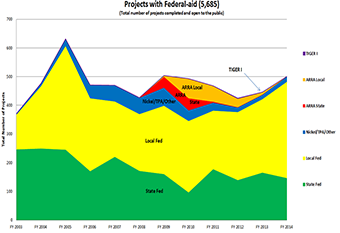
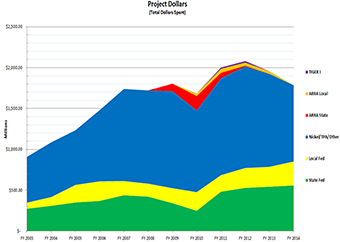
Over those 12 years, 5,685 projects totaling $19.48 billion dollars were completed and opened to traffic!
This chart shows the timeliness of FHWA Washington Division approval for emergency relief (ER) damage inspection reports. Our goal is to approve 90% of these reports within 10 days of receipt. ER reports that exceed 16 days typically are delayed due to external permits and other factors.
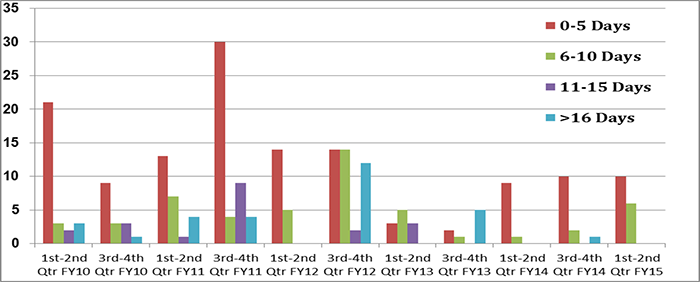
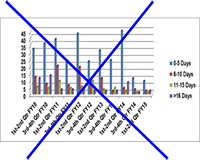
FHWA and WSDOT have had memorandums of understanding (MOUs) or Programmatic Agreement (PA) categorical exclusions (CEs) in place since the early 1990s, moving projects more quickly and allowing us to focus on projects of greater impact. 23 CFR 771.117 changes incorporated most of our PCEs, prompting us to terminate the agreement in March 2015. We are developing a new PCE agreement with greater delegation to the State. To that end, we've removed the CE review timeframes chart from this report and will provide regular updates on PAs as warranted.
Here are the Environmental PAs in place (with some results for the CE and Section 106 PAs):
- Programmatic CE (accounts for 98.5% of environmental documents used for projects)
- Endangered Species Act (ESA) Programmatic Consultation with NOAA (Marine Fisheries)—2012
This programmatic consultation between NOAA, FHWA, and WSDOT provides programmatic coverage for informal and some formal consultations. It includes a "Fast Track" process that does not require a NMFS approval for project actions deemed beneficial for listed fish such as fish barrier removal/culvert replacement projects.
- ESA Programmatic Consultations with USFWS (Eastern WA and Western WA)—2010 (update in process)
These programmatic consultations among USFWS, FHWA, and WSDOT have worked well since 2010. We are in the final stages of consolidating them into one statewide programmatic consultation.
- Sole Source Aquifer MOU with EPA – 2014
This MOU exempts many projects in areas with sole source aquifers from EPA review.
- Second Amended Statewide Section 106 PA with SHPO—2012
This third Section 106 PA streamlines our compliance process for Section 106 and delegates much of the Section 106 consultation to WSDOT. It exempts projects that are unlikely to harm cultural resources from Section 106 review, and defines roles and responsibilities. About half of WSDOT and Local Programs projects are exempt from Section 106 consultation under this agreement.
- Section 106 PA with US Forest Service and SHPO — 2012
This agreement streamlines the process of Section 106 Consultation for projects involving the US Forest Service (primarily projects occurring on or adjacent to USFS lands).
(106 PA Results:
In the 1st and 2nd quarter of FFY 2015, the FHWA Washington Division office completed 14 documented categorical exclusion (DCE), six 4(f), and two Section 106 approvals, all in less than seven days. We completed 16 emergency response damage inspection reports (DDIRs). A few examples of approvals are listed below.
| Authorized Within | 2010 | 2011 | 2012 | 2013 | 2014 | 2015 |
|---|---|---|---|---|---|---|
| 0 to 5 Days | 1936 | 1791 | 1655 | 2129 | 1879 | 985 |
| 6 to 10 Days | 131 | 41 | 35 | 122 | 123 | 35 |
| 11 to 15 Days | 18 | 7 | 1 | 7 | 9 | 7 |
| 16 to 20 Days | 3 | 2 | 0 | 0 | 0 | 0 |
| 20+ Days | 1 | 0 | 0 | 0 | 0 | 0 |
| TOTALS | 2089 | 1841 | 1691 | 2258 | 2011 | 1027 |
The table above reflects the number of FHWA Washington Division authorizations / modifications approved within certain timeframes since FY2010. For FY 2013, our overall approval within a two-week turnaround was 100%, exceeding our goal of 90%! Five-day FMIS approval turnaround for FY2014 is over 93%! (FY 2015 is in progress). (Note: The Federal Fiscal Year is October 1 through September 30, 2015 is in progress.)
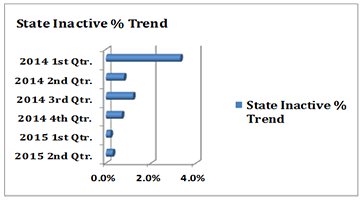
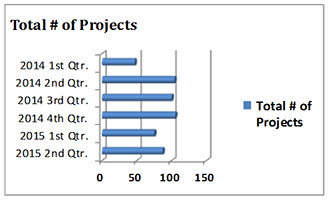
FHWA's quarterly target: under 2% inactivity on obligated federal funds. FHWA Washington Division continues to work well under that goal (under 0.5% so far this fiscal year!) The quarterly inactive percentage is found by dividing all projects inactive (no expenditures processed) for 12 months or more by each state's annual apportionments.
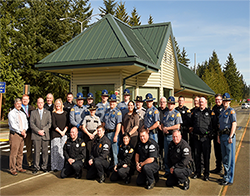
In March, Federal agencies joined WSP to
celebrate re-opening a weigh station in Everett.
On February 26, 2015, FHWA's Washington Division, Resource Center, and HQ Freight Office hosted an interagency self-assessment workshop on Truck Size and Weight (TS&W) in Olympia to discuss freight and commercial truck movement and its relationship to safety, enforcement, and infrastructure (bridges and pavement).
Leaders assembled from Washington State Patrol's (WSP) Commercial Vehicle Services Division; WSDOT managers from Bridge, Safety, GIS/Data, Commercial Vehicle Services, and Freight; the Freight Mobility Strategic Investment Board; the Federal Motor Carrier Safety Administration's Washington Division; and FHWA Washington Division staff from Safety, Bridge, Freight, and Leadership.
Follow-up meetings started right way to discuss plan action items identified during the workshop. For example, WSP and WSDOT Bridge have begun an emphasis patrol for low-weight bridges; and WSP, Bridge, and Traffic Data are evaluating the availability of data from 35 WSDOT weigh-in-motion (WIM) sites.
Impact steel pile-driving in water produces extremely high noise levels that can injure and sometimes kill fish, birds, and marine mammals. Pile-driving projects (bridges, ferry terminals/docks, etc.) along the U.S. west coast must often minimize these sound levels to protect Endangered Species Act (ESA)-listed and marine mammal species in the project area. Existing noise attenuation methods (bubble curtains, cofferdams, and isolation casings) can be limited in effectiveness and cumbersome to install, resulting in delays during construction. These methods provide average noise reductions of only 8 to 12 decibels (dB).
The University of Washington (UW) Department of Mechanical Engineering, with sponsorship from the Washington State DOT (WSDOT) and FHWA, conducted a full-scale test in Puget Sound in October 2014 of two new pile designs: a double-walled pile, and a mandrel pile using the double-walled technology. The two tested piles achieved 21-23 dB PEAK noise reduction vs. the standard pile, compared to a 3-6 dB PEAK noise reduction for the bubble curtain, indicating the potential for significant advancement in underwater noise attenuation technology. FHWA is encouraged by these preliminary findings. The new approach will be tested on a ferry terminal project at Vashon Island (2015).
| Standard Pile | Bubble Curtain | Double-Walled Pile |
 |
 |
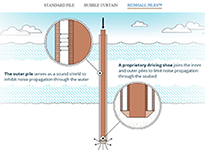 |
| For more information contact: | ||
|---|---|---|
| Dan Mathis Division Administrator FHWA Washington Division 360-753-9480 Daniel.Mathis@dot.gov |
Sharleen Bakeman Transportation Specialist - Planning FHWA Washington Division 360-753-9418 Sharleen.Bakeman@dot.gov |
 |